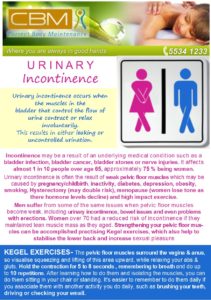Urinary Incontinence
U R I N A R Y Incontinence
Urinary incontinence occurs when the muscles in the bladder that control the flow of urine contract or relax involuntarily.
This results in either leaking or uncontrolled urination.
Incontinence may be a result of an underlying medical condition such as a bladder infection, bladder cancer, bladder stones or nerve injuries. It affects almost 1 in 10 people over age 65, approximately 75 % being women.
Urinary incontinence is often the result of weak pelvic floor muscles which may be caused by pregnancy/childbirth, inactivity, diabetes, depression, obesity, smoking, Hysterectomy (may double risk), menopause (women lose tone as there hormone levels decline) and high impact exercise.
Men suffer from some of the same issues when pelvic floor muscle become weak, including urinary incontinence, bowel issues and even problems with erections. Women over 70 had a reduced risk of incontinence if they maintained lean muscle mass as they aged. Strengthening your pelvic floor muscles can be accomplished practising Kegel exercises, which also help to stabilise the lower back and increase sexual pleasure
KEGEL EXERCISES- The pelvic floor muscles surround the vagina & anus, so visualise squeezing and lifting of this area upward, while relaxing your abs & gluts. Hold the contraction for 5 to 8 seconds , remembering to breath and do up to 10 repetitions. After learning how to do them and isolating the muscles, you can do them sitting in your chair or standing. It’s easier to remember to do them daily if you associate them with another activity you do daily, such as brushing your teeth, driving or checking your email.
Other ways to strengthen your pelvic floor include:
Remember to breathe in and out during activities and don’t hold your breath, including while having bowel movements or doing crunches. Try to use correct posture and form, including stabilizing your abdominal muscles and engaging the pelvic floor during instances of higher stress, such as lifting or pushing.
Practice good posture– avoid having an arched back and engage abdominal muscles throughout the day. Engaging these muscles helps to keep your head to hips in proper alignment and reduce pressure and strain on your lower back, hips and pelvic floor. Also keep your head and hips aligned.
Practice hip and body circles or moving side to side, this engages your hips, also attached to your pelvic floor.
How Chiropractic can help with urinary Incontinence – Changes to posture may not only affect your back or neck but it can also affect the alignment of your pelvis, which houses your digestive organs and bladder. If the angle of your pelvis is slightly off then these organs, particularly your bladder, is affected. When young, your pelvic floor muscles are generally strong enough to compensate for bad posture. But, as you age, the tissues throughout your body can become less resilient – unfortunately, that will include the muscles of your pelvic floor as well.



